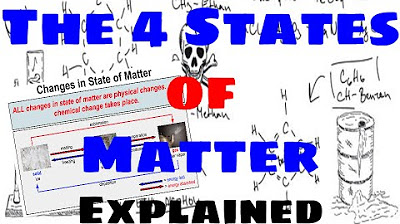Phases of Mitosis
Summary
TLDRIn this educational video, Mr. Andersen explores the intricate process of mitosis, focusing on the various phases and their significance in cell division. He explains the purpose of mitosis in creating identical daughter cells and its role in the cell cycle. The video visually guides viewers through each phase, from interphase to cytokinesis, highlighting key structures like the cell membrane, nuclear envelope, centrosomes, and chromosomes. The use of a mnemonic, 'IPPMATC,' helps viewers remember the sequence of phases, making the complex process more accessible.
Takeaways
- 🔬 Mitosis is a biological process that ensures two identical daughter cells are produced from one parent cell, which is crucial for growth, repair, and maintenance of an organism's tissues.
- 🌀 The cell cycle, which includes mitosis, is the process by which a cell duplicates itself, with the majority of time spent in the interphase, where the cell grows and DNA is replicated.
- 🟡 Interphase consists of G1, S, and G2 phases, where the cell grows, duplicates its DNA, and continues growing before entering the M phase, which is the actual division phase.
- 🏃♂️ Not all cells undergo the full cell cycle; some, like nerve and muscle cells, enter a G0 phase where they do not divide.
- 📉 The M phase of the cell cycle includes the stages of mitosis, where the cell's nucleus divides, and cytokinesis, where the cytoplasm divides to form two daughter cells.
- 🌈 A classic lab experiment involves observing cells undergoing mitosis, such as onion cells, where chromosomes are dyed to visualize the process.
- 🎥 Mitosis should be viewed as a continuous process, like a movie, rather than as individual, quickly changing phases, emphasizing the dynamic nature of cell division.
- 🧬 Chromosomes, which contain the genetic information, condense during mitosis, and sister chromatids, exact copies of DNA formed during S phase, are separated and distributed to the daughter cells.
- 🧲 The centrosome, containing centrioles and organizing microtubules, plays a critical role in forming the spindle fibers that help segregate chromosomes during mitosis.
- 🔄 The nuclear envelope breaks down during prometaphase and reforms around the separated chromatids in telophase, illustrating the dynamic changes in the nuclear structure during cell division.
- 📚 Memorizing the phases of mitosis can be aided by the mnemonic 'IPPMATC', which stands for Interphase, Prophase, Prometaphase, Metaphase, Anaphase, Telophase, and Cytokinesis.
Q & A
What is the main focus of the video by Mr. Andersen?
-The main focus of the video is to explain the phases of mitosis, ensuring viewers can identify different stages and understand the purpose of mitosis in cell division.
What are the two main goals of mitosis as described in the video?
-The two main goals of mitosis are to ensure that two exact daughter cells are created that are identical to the parent cell and to replace cells as they die over time.
What is the significance of the cell cycle in relation to mitosis?
-The cell cycle is significant as it represents how a cell duplicates itself, with mitosis being a part of it. It includes the phases of cell growth, DNA replication, and preparation for cell division.
What are the different phases of the cell cycle mentioned in the script?
-The different phases of the cell cycle mentioned are interphase (G1, S, and G2 phases), and the M phase which includes mitosis (prophase, prometaphase, metaphase, anaphase, and telophase).
What happens during the S phase of interphase?
-During the S phase of interphase, the cell duplicates all of its DNA in preparation for cell division.
Why do some cells enter the G0 phase instead of continuing the cell cycle?
-Some cells, like nerve and muscle cells, enter the G0 phase because they do not divide. They remain in this phase indefinitely, not undergoing cell division.
What is the role of the centrosome in mitosis?
-The centrosome plays a crucial role in mitosis by organizing the microtubules that form the spindle, which is essential for the equal division of chromosomes between the two daughter cells.
What is the significance of the kinetochore during mitosis?
-The kinetochore is significant during mitosis as it is a protein structure that attaches to the microtubules of the spindle, ensuring the proper alignment and separation of sister chromatids.
How does the cell membrane change during mitosis?
-The cell membrane remains relatively unchanged during most of mitosis, but at the end of cytokinesis, it forms a cleavage furrow, dividing the cell into two separate cells.
What is the function of the nuclear envelope during mitosis?
-The nuclear envelope fragments during prometaphase, allowing the spindle fibers to access the chromosomes. After the chromosomes are separated, the fragments reform to create new nuclear envelopes around the daughter nuclei.
What is the mnemonic 'IPPMATC' mentioned in the video, and how does it help in remembering the phases of mitosis?
-The mnemonic 'IPPMATC' stands for Interphase, Prophase, Prometaphase, Metaphase, Anaphase, Telophase, and Cytokinesis. It is a tool to help remember the order of the phases of mitosis, including the non-mitotic phases.
Outlines

このセクションは有料ユーザー限定です。 アクセスするには、アップグレードをお願いします。
今すぐアップグレードMindmap

このセクションは有料ユーザー限定です。 アクセスするには、アップグレードをお願いします。
今すぐアップグレードKeywords

このセクションは有料ユーザー限定です。 アクセスするには、アップグレードをお願いします。
今すぐアップグレードHighlights

このセクションは有料ユーザー限定です。 アクセスするには、アップグレードをお願いします。
今すぐアップグレードTranscripts

このセクションは有料ユーザー限定です。 アクセスするには、アップグレードをお願いします。
今すぐアップグレード関連動画をさらに表示

The Four States of Matter - Explained

Lab Equipment - Explained

3. Gr 11 Life Sciences - Population Ecology - Theory 3 Mark Recapture Method

4. Gr 11 Life Sciences - Population Ecology - Worksheet 1

PENJASKES KELAS X - SOFTBALL

Introduction to Culture [AP Human Geography Review Unit 3 Topic 1]

Menentukan Mr ( massa molekul relatif )
5.0 / 5 (0 votes)
